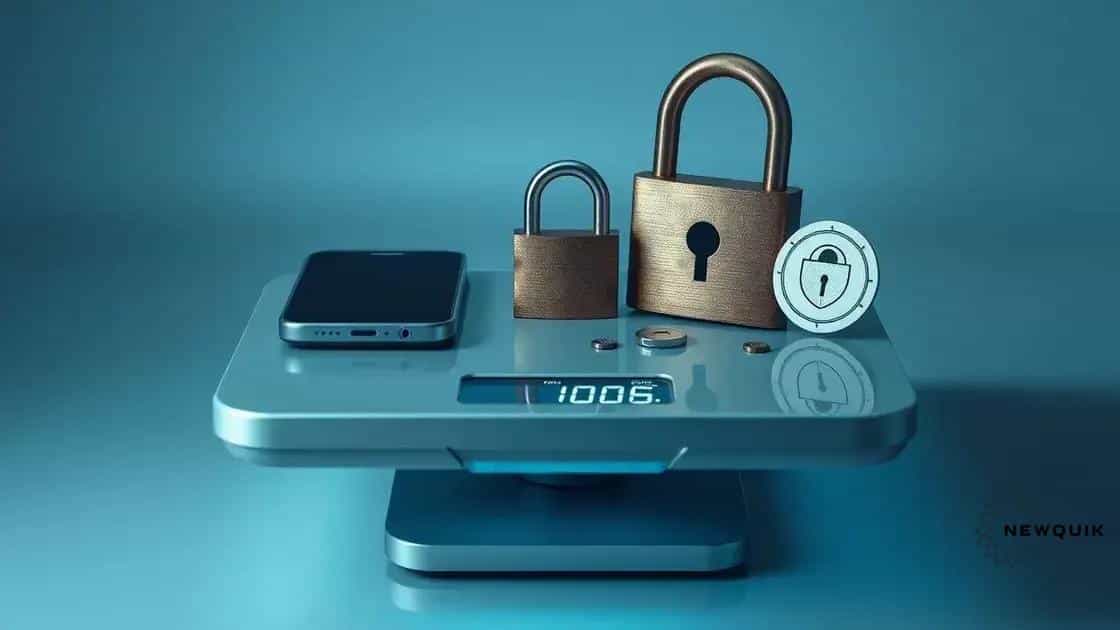Digital identity: balancing convenience and privacy

Anúncios
Digital identity management is essential for controlling online personal information, enhancing security through practices like strong password use, privacy setting reviews, and leveraging AI for identity verification.
Digital identity has become a cornerstone of our online lives, shaping how we interact, shop, and connect. But how do we balance convenience with privacy in this modern age? Let’s dive into this pressing issue.
Anúncios
Understanding digital identity
Understanding digital identity is essential in our increasingly technology-driven world. It refers to the online presence and data associated with individuals. This identity can include personal information, social media profiles, and online behaviors. As we navigate the internet, it’s crucial to comprehend how these elements shape our digital lives.
Components of Digital Identity
There are several key components that make up your digital identity:
- Personal Information: This includes your name, email address, and contact details.
- Social Media Profiles: Your interactions and posts on platforms like Facebook, Twitter, and Instagram.
- Online Behaviors: How you browse websites, purchase products, and engage online.
- Digital Footprint: The trail of data you leave behind as you use the internet.
Each of these components contributes to how others perceive you online. Understanding your digital identity can empower you to manage your information better and protect your privacy.
Anúncios
Why Digital Identity Matters
Managing your digital identity is important for several reasons. First, it impacts your online reputation. Employers and others often check social media or online profiles when making decisions. Secondly, securing your personal information helps protect you from identity theft. Ultimately, a well-managed digital identity can help build trust with others.
It’s vital to regularly review your online presence, ensuring that your information is accurate and reflects your values. Engaging with your audience responsibly helps maintain credibility and fosters positive relationships.
Tips for Managing Your Digital Identity
Here are some practical tips for managing your digital identity:
- Regularly update your privacy settings on social media.
- Be cautious about the information you share online.
- Monitor your online presence by Google searching your name.
- Consider using a password manager to enhance security.
By taking these steps, individuals can effectively control their digital identity, balancing both convenience and privacy. As the digital landscape continues to evolve, staying informed will help you navigate the complexities of your online life.
The importance of privacy in the digital age
The importance of privacy in the digital age cannot be overstated. With so much of our lives being conducted online, protecting our personal information is more crucial than ever. Privacy ensures that individuals can control their personal data and how it is used.
Understanding Privacy Risks
As we engage with various platforms, we expose ourselves to numerous risks. Knowing these risks helps us make informed decisions. Here are some common privacy risks:
- Data Breaches: Hackers may access sensitive information, leading to identity theft.
- Tracking Technologies: Websites and apps often track user behavior, which can be invasive.
- Social Engineering: Scammers exploit personal information to manipulate users.
- Lack of Encryption: Without proper security, data can be intercepted during transmission.
Each of these risks highlights the need for strong privacy measures when utilizing digital services.
Benefits of Protecting Your Privacy
Protecting your privacy offers many benefits. It builds trust in your relationships and keeps your personal life secure. When you take privacy seriously, you can enjoy the following advantages:
- Enhanced Security: Keeping your data safe from unauthorized access.
- Greater Control: Deciding who can see your information.
- Reduced Spam: Limiting unwanted advertisements and communications.
- Peace of Mind: Knowing your information is secure lets you use the internet more freely.
The digital landscape is always evolving, and as such, the threats to our privacy also change. Staying informed about these threats is essential to maintaining control over your digital life. Regularly updating passwords, using privacy settings, and being cautious about what you share are effective strategies.
Furthermore, it’s vital to advocate for your privacy rights. Engaging with organizations that promote digital privacy can help raise awareness. Together, we can promote a safer digital environment for everyone.
Convenience versus privacy: finding the balance

Finding the balance between convenience and privacy is a common challenge in today’s digital world. While technology makes our lives easier, it often comes at the cost of our personal information. It’s essential to understand how to enjoy the benefits of technology without compromising our privacy.
Understanding the Trade-offs
Every time we use an app or a service, we face a trade-off between convenience and privacy. For instance, mobile apps that track our location greatly enhance user experience, but they also collect highly personal data. Understanding these trade-offs helps us make informed choices.
- Location Services: Useful for navigation but can expose personal habits.
- Social Media Sharing: Connects us with friends but can reveal too much about our lives.
- Web Cookies: Help websites remember our preferences but may track our online behavior.
- Shopping Apps: Simplify buying but require access to sensitive information.
These examples illustrate how our desire for ease must be balanced against the risk of unwanted exposure.
Strategies to Maintain Balance
There are effective ways to strike a balance between convenience and privacy. Here are some strategies to consider:
- Review Privacy Settings: Regularly check the privacy settings on your devices and apps.
- Be Selective with Sharing: Only share personal information when absolutely necessary.
- Utilize Privacy Tools: Browser extensions or apps can enhance privacy.
- Limit Location Access: Turn off location services for apps that don’t need it.
Employing these strategies allows you to enjoy technological conveniences while safeguarding your personal data. Always think critically about the information you share.
Ultimately, achieving a healthy balance requires ongoing awareness and proactive decision-making. As new technologies emerge, staying informed about their implications on privacy is vital. By making thoughtful choices, we can enjoy the benefits of technology without sacrificing our personal information.
Practical tips for managing your digital identity
Managing your digital identity is essential in this interconnected world. With our lives increasingly online, it’s important to take active steps to protect ourselves. This includes safeguarding personal information and being mindful of how we present ourselves digitally.
Establish Strong Passwords
One of the most effective ways to manage your digital identity is by using strong passwords. Weak passwords make your accounts vulnerable to hacking. Here are some tips for creating strong passwords:
- Use a mix of upper and lowercase letters, numbers, and symbols.
- Avoid using easily guessed information like birthdays or names.
- Consider using a password manager to keep track of your passwords securely.
- Change your passwords regularly, especially for sensitive accounts.
These practices can greatly enhance your account security and protect your digital identity.
Review Privacy Settings
Regularly reviewing the privacy settings on your social media accounts and devices is crucial. Each platform has different privacy options, and adjusting them can help you maintain control over your information:
- Limit who can see your posts and personal information.
- Disable location services for apps that do not require them.
- Turn off facial recognition features if you are not comfortable with them.
Being proactive about privacy settings is a vital step in managing your digital identity.
Additionally, it’s wise to be cautious about what information you share online. Think before posting personal details, photos, or opinions, as once something is online, it can be difficult to remove. Ensure that your online presence reflects your values and the image you want to project.
Finally, regularly monitoring your digital identity can help you stay informed about what information is available online. Perform Google searches on your name to see what comes up and take action if you find anything concerning. This vigilance helps you maintain a positive online reputation.
Future trends in digital identity management
Future trends in digital identity management are evolving rapidly as technology advances. As our dependence on digital services increases, so does the importance of how we manage our identities online. Understanding these trends can help individuals and businesses prepare for a secure future.
Decentralized Identity Systems
One major trend is the move towards decentralized identity systems. These systems allow users to control their own data, reducing the need for centralized databases. This can lead to greater security and privacy. Key benefits include:
- Ownership of Data: Users can control who accesses their information.
- Enhanced Security: Reduces the risk of data breaches associated with central repositories.
- Simplified Verification: Streamlines the verification process across different platforms.
As more organizations adopt decentralized solutions, the landscape of digital identity management will significantly change.
Artificial Intelligence in Identity Verification
Another emerging trend is the use of artificial intelligence (AI) for identity verification. AI can analyze user behavior and detect anomalies, making it easier to spot fraudulent activities. Important aspects include:
- Behavior Analytics: AI can monitor trends in user behavior to identify potential threats.
- Facial Recognition: Enhancements in this technology are improving security measures.
- Automated Risk Assessment: AI systems can automatically assess the risk of transactions based on user data.
The integration of AI into digital identity management can lead to safer and more streamlined experiences for users.
Privacy-preserving technologies, like zero-knowledge proofs, are also gaining traction. These allow users to prove their identity without revealing their personal data. This trend aligns with the growing focus on privacy in the digital space.
As we look to the future, staying informed about these trends in digital identity management will help individuals and organizations adapt to technological changes. By embracing innovative solutions, users can enhance their security while maintaining control over their personal information.
FAQ – Frequently Asked Questions about Digital Identity Management
What is a digital identity?
A digital identity is the online representation of an individual, including personal information, social media profiles, and online behavior.
How can I protect my digital identity?
You can protect your digital identity by using strong passwords, reviewing privacy settings, and being cautious about the information you share online.
What are the risks associated with poor digital identity management?
Poor management can lead to data breaches, identity theft, and a negative online reputation.
What role does AI play in digital identity management?
AI enhances security by analyzing user behavior, detecting anomalies, and streamlining identity verification processes.




